Workers Compensation's Influence on Employee Productivity: A Study
VerifiedAdded on 2021/04/21
|11
|2351
|65
Report
AI Summary
This report investigates the impact of workers' compensation on employee productivity, employing a qualitative research methodology. The study focuses on a single hotel, using purposive sampling to interview one supervisor and collect secondary data from various sources. Data collection involved structured interviews with open-ended questions and analysis using open coding and axial coding techniques. The report addresses ethical considerations, ensuring confidentiality and informed consent, while acknowledging limitations such as the potential for biased responses and the challenges of secondary data reliability. The findings aim to provide insights into how compensation affects employee performance and suggest recommendations for improving compensation plans to enhance productivity within the hotel setting. The report covers methodology, data collection, analysis, ethical considerations, and limitations.
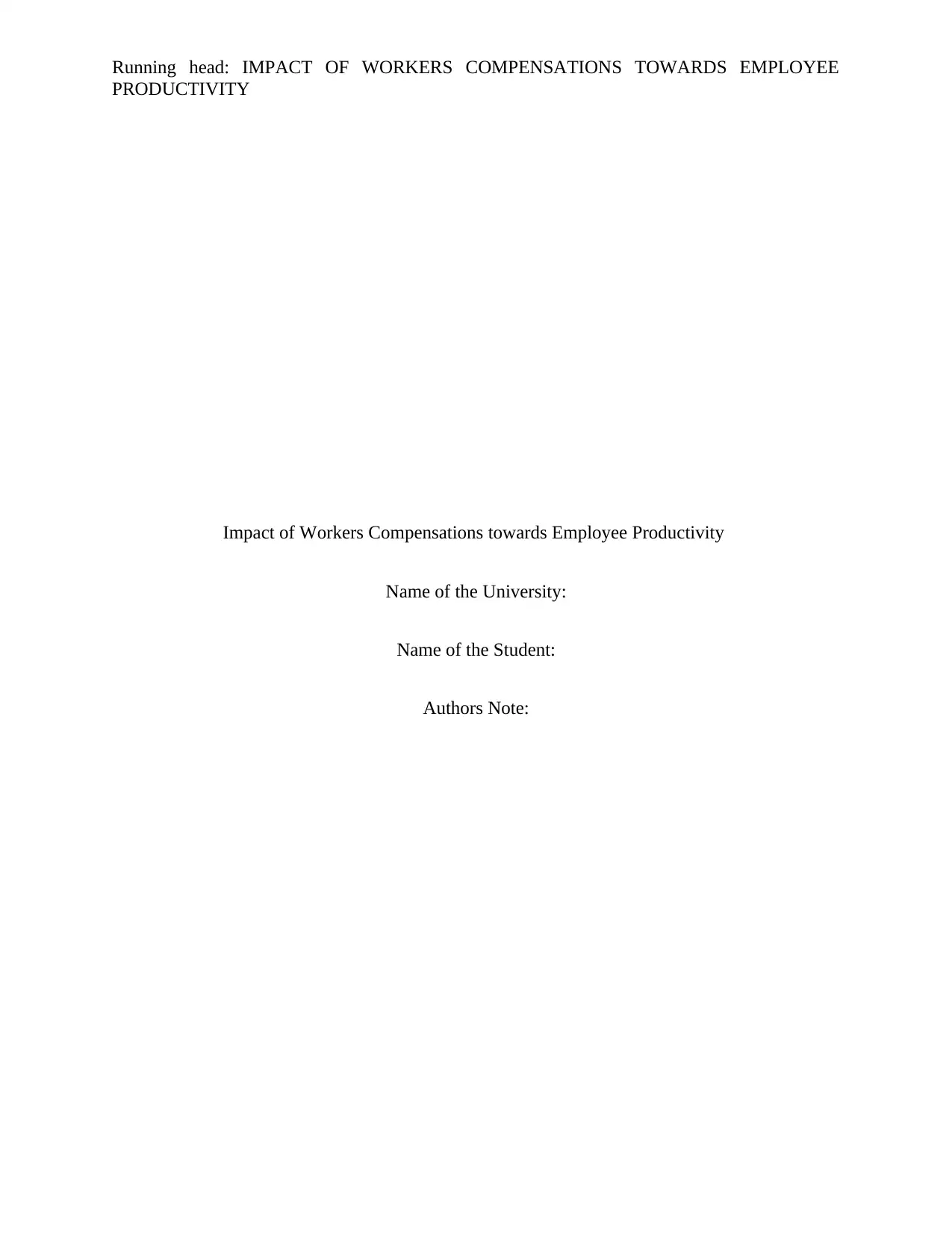
Running head: IMPACT OF WORKERS COMPENSATIONS TOWARDS EMPLOYEE
PRODUCTIVITY
Impact of Workers Compensations towards Employee Productivity
Name of the University:
Name of the Student:
Authors Note:
PRODUCTIVITY
Impact of Workers Compensations towards Employee Productivity
Name of the University:
Name of the Student:
Authors Note:
Paraphrase This Document
Need a fresh take? Get an instant paraphrase of this document with our AI Paraphraser
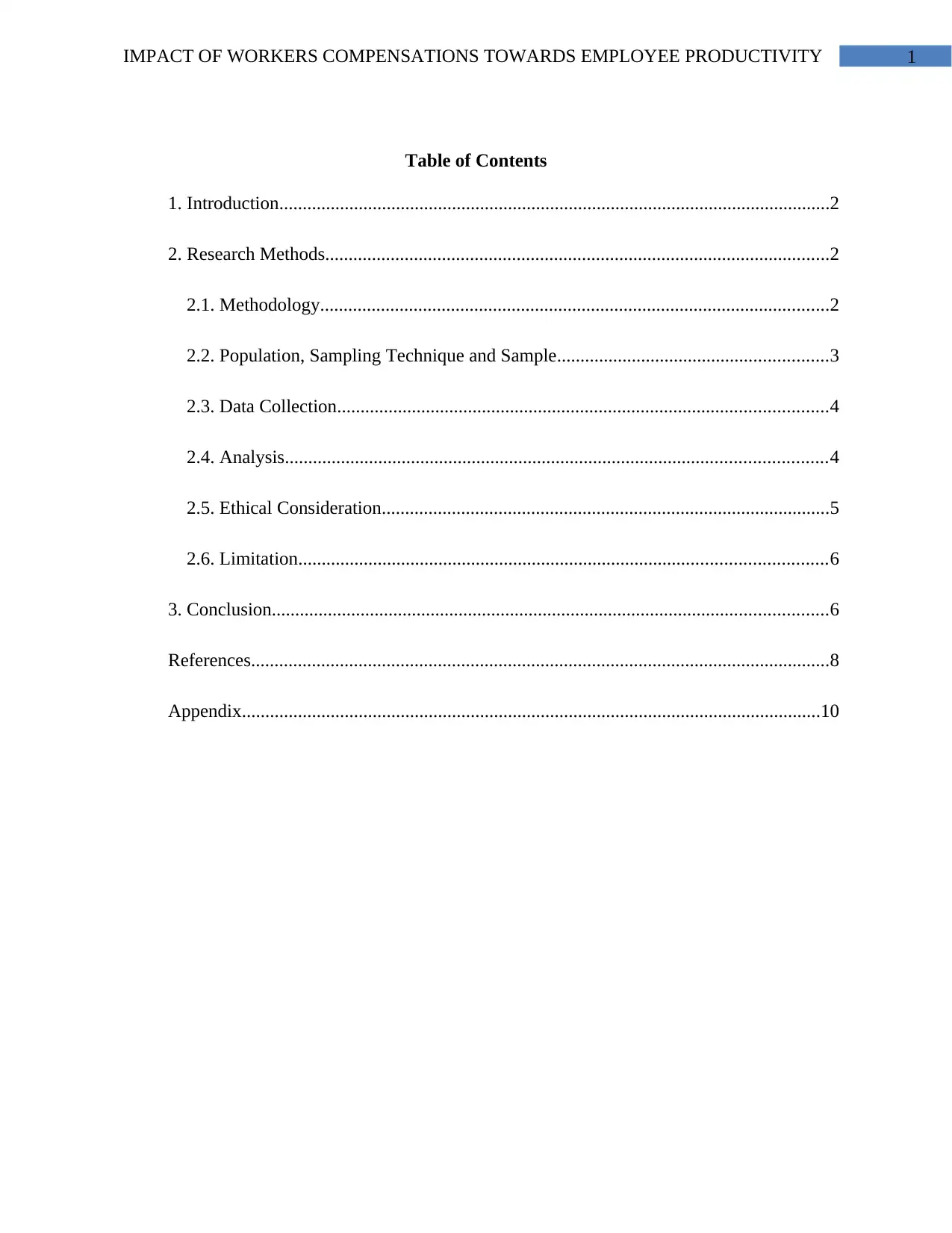
IMPACT OF WORKERS COMPENSATIONS TOWARDS EMPLOYEE PRODUCTIVITY 1
Table of Contents
1. Introduction......................................................................................................................2
2. Research Methods............................................................................................................2
2.1. Methodology.............................................................................................................2
2.2. Population, Sampling Technique and Sample..........................................................3
2.3. Data Collection.........................................................................................................4
2.4. Analysis....................................................................................................................4
2.5. Ethical Consideration................................................................................................5
2.6. Limitation.................................................................................................................6
3. Conclusion.......................................................................................................................6
References............................................................................................................................8
Appendix............................................................................................................................10
Table of Contents
1. Introduction......................................................................................................................2
2. Research Methods............................................................................................................2
2.1. Methodology.............................................................................................................2
2.2. Population, Sampling Technique and Sample..........................................................3
2.3. Data Collection.........................................................................................................4
2.4. Analysis....................................................................................................................4
2.5. Ethical Consideration................................................................................................5
2.6. Limitation.................................................................................................................6
3. Conclusion.......................................................................................................................6
References............................................................................................................................8
Appendix............................................................................................................................10
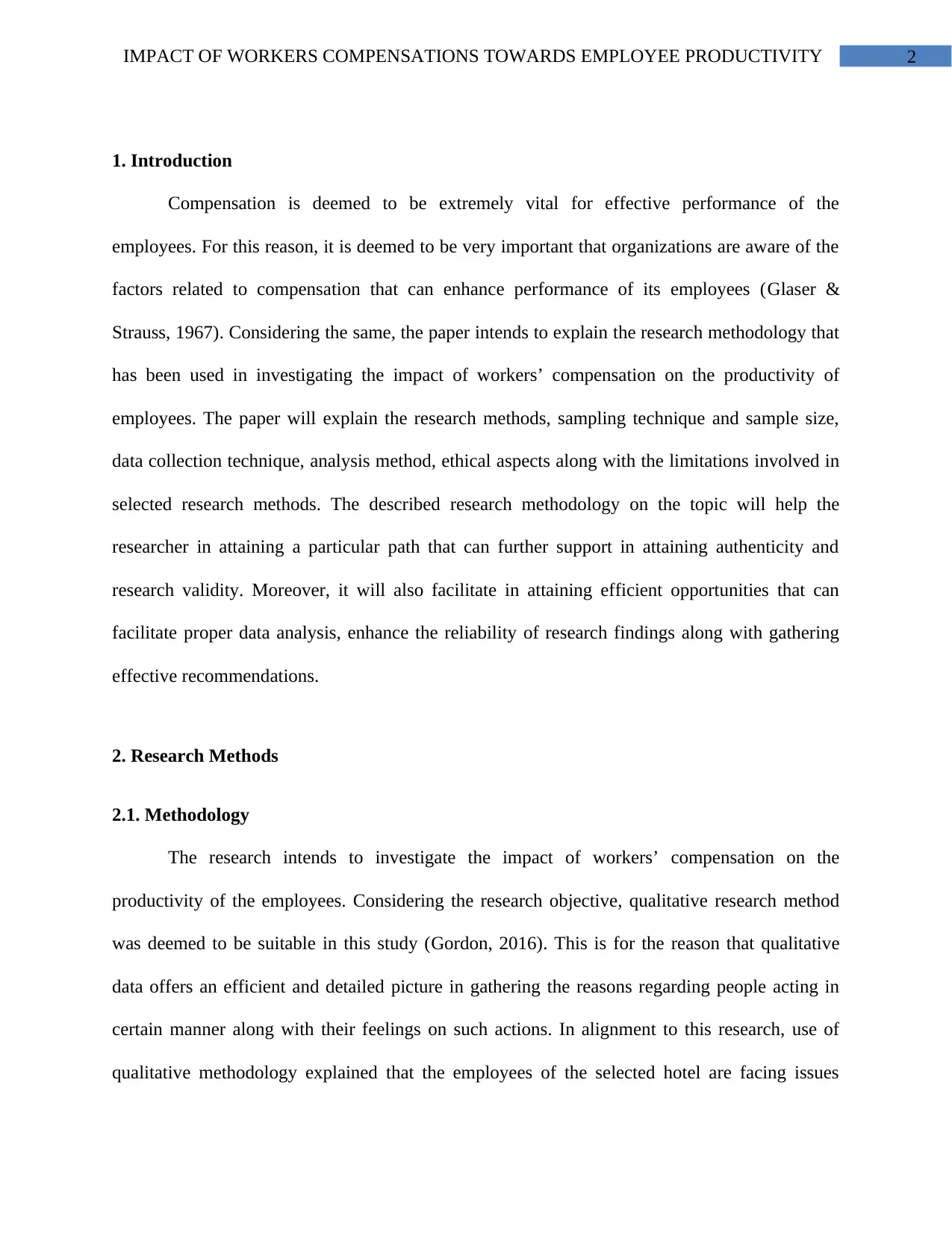
IMPACT OF WORKERS COMPENSATIONS TOWARDS EMPLOYEE PRODUCTIVITY 2
1. Introduction
Compensation is deemed to be extremely vital for effective performance of the
employees. For this reason, it is deemed to be very important that organizations are aware of the
factors related to compensation that can enhance performance of its employees (Glaser &
Strauss, 1967). Considering the same, the paper intends to explain the research methodology that
has been used in investigating the impact of workers’ compensation on the productivity of
employees. The paper will explain the research methods, sampling technique and sample size,
data collection technique, analysis method, ethical aspects along with the limitations involved in
selected research methods. The described research methodology on the topic will help the
researcher in attaining a particular path that can further support in attaining authenticity and
research validity. Moreover, it will also facilitate in attaining efficient opportunities that can
facilitate proper data analysis, enhance the reliability of research findings along with gathering
effective recommendations.
2. Research Methods
2.1. Methodology
The research intends to investigate the impact of workers’ compensation on the
productivity of the employees. Considering the research objective, qualitative research method
was deemed to be suitable in this study (Gordon, 2016). This is for the reason that qualitative
data offers an efficient and detailed picture in gathering the reasons regarding people acting in
certain manner along with their feelings on such actions. In alignment to this research, use of
qualitative methodology explained that the employees of the selected hotel are facing issues
1. Introduction
Compensation is deemed to be extremely vital for effective performance of the
employees. For this reason, it is deemed to be very important that organizations are aware of the
factors related to compensation that can enhance performance of its employees (Glaser &
Strauss, 1967). Considering the same, the paper intends to explain the research methodology that
has been used in investigating the impact of workers’ compensation on the productivity of
employees. The paper will explain the research methods, sampling technique and sample size,
data collection technique, analysis method, ethical aspects along with the limitations involved in
selected research methods. The described research methodology on the topic will help the
researcher in attaining a particular path that can further support in attaining authenticity and
research validity. Moreover, it will also facilitate in attaining efficient opportunities that can
facilitate proper data analysis, enhance the reliability of research findings along with gathering
effective recommendations.
2. Research Methods
2.1. Methodology
The research intends to investigate the impact of workers’ compensation on the
productivity of the employees. Considering the research objective, qualitative research method
was deemed to be suitable in this study (Gordon, 2016). This is for the reason that qualitative
data offers an efficient and detailed picture in gathering the reasons regarding people acting in
certain manner along with their feelings on such actions. In alignment to this research, use of
qualitative methodology explained that the employees of the selected hotel are facing issues
⊘ This is a preview!⊘
Do you want full access?
Subscribe today to unlock all pages.

Trusted by 1+ million students worldwide
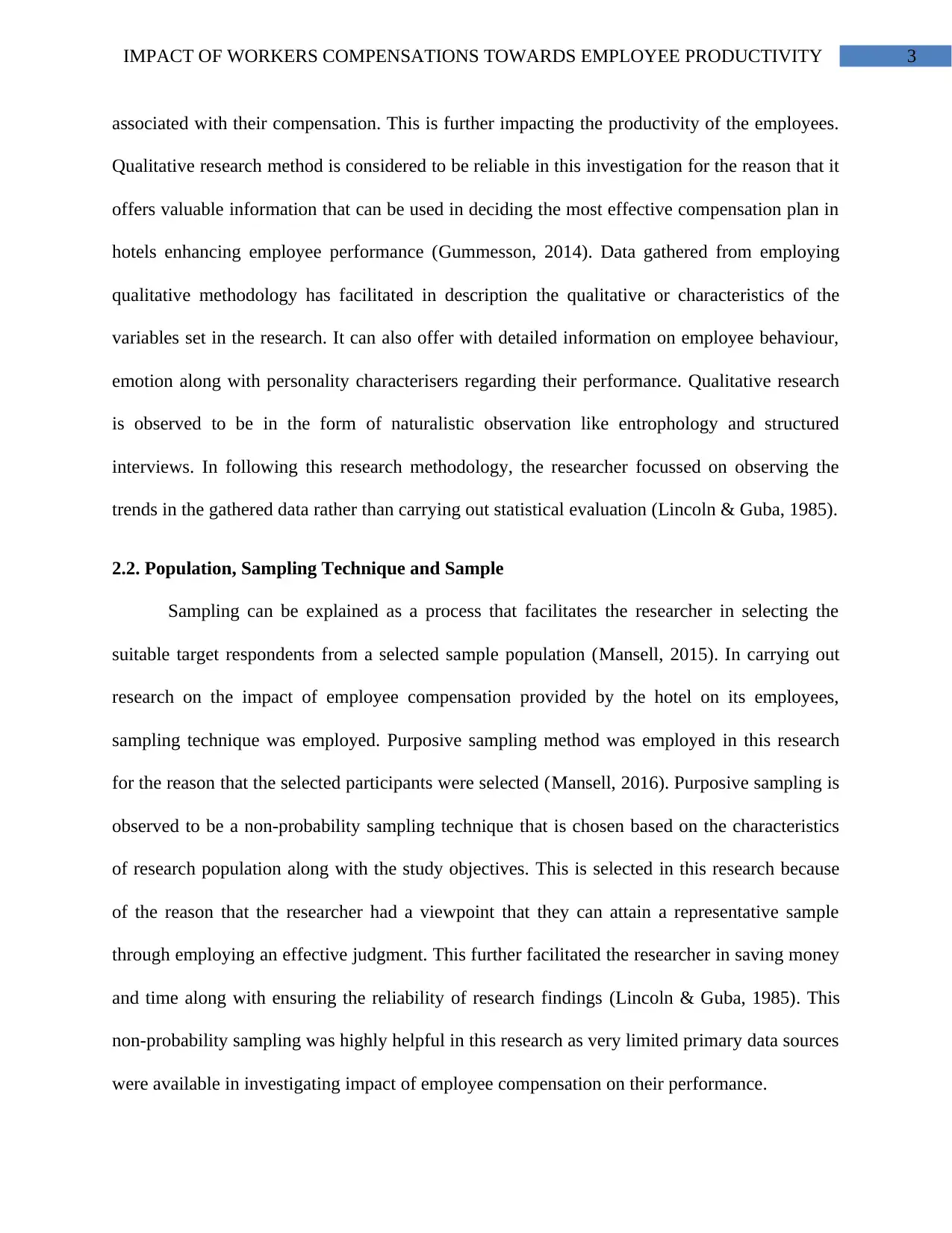
IMPACT OF WORKERS COMPENSATIONS TOWARDS EMPLOYEE PRODUCTIVITY 3
associated with their compensation. This is further impacting the productivity of the employees.
Qualitative research method is considered to be reliable in this investigation for the reason that it
offers valuable information that can be used in deciding the most effective compensation plan in
hotels enhancing employee performance (Gummesson, 2014). Data gathered from employing
qualitative methodology has facilitated in description the qualitative or characteristics of the
variables set in the research. It can also offer with detailed information on employee behaviour,
emotion along with personality characterisers regarding their performance. Qualitative research
is observed to be in the form of naturalistic observation like entrophology and structured
interviews. In following this research methodology, the researcher focussed on observing the
trends in the gathered data rather than carrying out statistical evaluation (Lincoln & Guba, 1985).
2.2. Population, Sampling Technique and Sample
Sampling can be explained as a process that facilitates the researcher in selecting the
suitable target respondents from a selected sample population (Mansell, 2015). In carrying out
research on the impact of employee compensation provided by the hotel on its employees,
sampling technique was employed. Purposive sampling method was employed in this research
for the reason that the selected participants were selected (Mansell, 2016). Purposive sampling is
observed to be a non-probability sampling technique that is chosen based on the characteristics
of research population along with the study objectives. This is selected in this research because
of the reason that the researcher had a viewpoint that they can attain a representative sample
through employing an effective judgment. This further facilitated the researcher in saving money
and time along with ensuring the reliability of research findings (Lincoln & Guba, 1985). This
non-probability sampling was highly helpful in this research as very limited primary data sources
were available in investigating impact of employee compensation on their performance.
associated with their compensation. This is further impacting the productivity of the employees.
Qualitative research method is considered to be reliable in this investigation for the reason that it
offers valuable information that can be used in deciding the most effective compensation plan in
hotels enhancing employee performance (Gummesson, 2014). Data gathered from employing
qualitative methodology has facilitated in description the qualitative or characteristics of the
variables set in the research. It can also offer with detailed information on employee behaviour,
emotion along with personality characterisers regarding their performance. Qualitative research
is observed to be in the form of naturalistic observation like entrophology and structured
interviews. In following this research methodology, the researcher focussed on observing the
trends in the gathered data rather than carrying out statistical evaluation (Lincoln & Guba, 1985).
2.2. Population, Sampling Technique and Sample
Sampling can be explained as a process that facilitates the researcher in selecting the
suitable target respondents from a selected sample population (Mansell, 2015). In carrying out
research on the impact of employee compensation provided by the hotel on its employees,
sampling technique was employed. Purposive sampling method was employed in this research
for the reason that the selected participants were selected (Mansell, 2016). Purposive sampling is
observed to be a non-probability sampling technique that is chosen based on the characteristics
of research population along with the study objectives. This is selected in this research because
of the reason that the researcher had a viewpoint that they can attain a representative sample
through employing an effective judgment. This further facilitated the researcher in saving money
and time along with ensuring the reliability of research findings (Lincoln & Guba, 1985). This
non-probability sampling was highly helpful in this research as very limited primary data sources
were available in investigating impact of employee compensation on their performance.
Paraphrase This Document
Need a fresh take? Get an instant paraphrase of this document with our AI Paraphraser
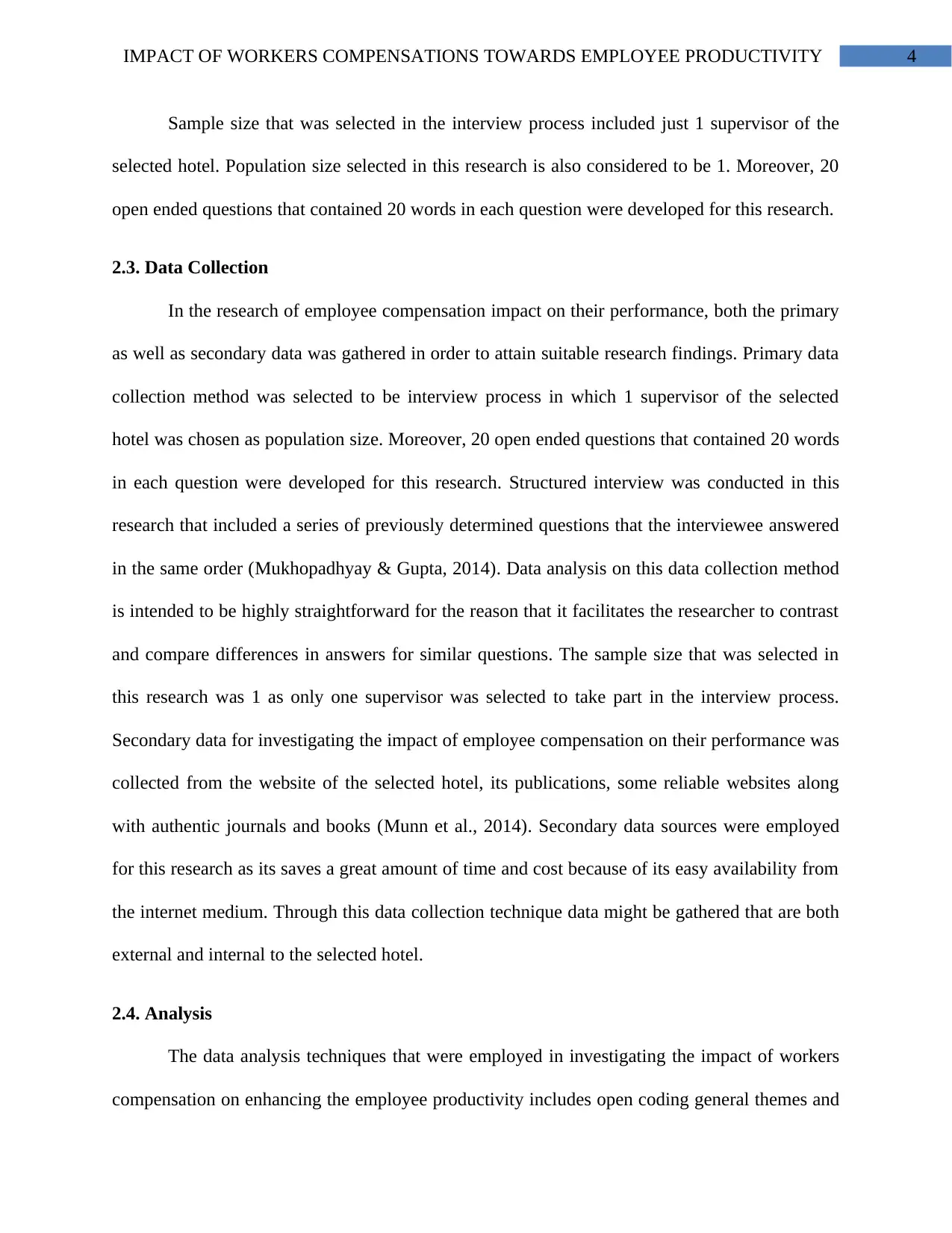
IMPACT OF WORKERS COMPENSATIONS TOWARDS EMPLOYEE PRODUCTIVITY 4
Sample size that was selected in the interview process included just 1 supervisor of the
selected hotel. Population size selected in this research is also considered to be 1. Moreover, 20
open ended questions that contained 20 words in each question were developed for this research.
2.3. Data Collection
In the research of employee compensation impact on their performance, both the primary
as well as secondary data was gathered in order to attain suitable research findings. Primary data
collection method was selected to be interview process in which 1 supervisor of the selected
hotel was chosen as population size. Moreover, 20 open ended questions that contained 20 words
in each question were developed for this research. Structured interview was conducted in this
research that included a series of previously determined questions that the interviewee answered
in the same order (Mukhopadhyay & Gupta, 2014). Data analysis on this data collection method
is intended to be highly straightforward for the reason that it facilitates the researcher to contrast
and compare differences in answers for similar questions. The sample size that was selected in
this research was 1 as only one supervisor was selected to take part in the interview process.
Secondary data for investigating the impact of employee compensation on their performance was
collected from the website of the selected hotel, its publications, some reliable websites along
with authentic journals and books (Munn et al., 2014). Secondary data sources were employed
for this research as its saves a great amount of time and cost because of its easy availability from
the internet medium. Through this data collection technique data might be gathered that are both
external and internal to the selected hotel.
2.4. Analysis
The data analysis techniques that were employed in investigating the impact of workers
compensation on enhancing the employee productivity includes open coding general themes and
Sample size that was selected in the interview process included just 1 supervisor of the
selected hotel. Population size selected in this research is also considered to be 1. Moreover, 20
open ended questions that contained 20 words in each question were developed for this research.
2.3. Data Collection
In the research of employee compensation impact on their performance, both the primary
as well as secondary data was gathered in order to attain suitable research findings. Primary data
collection method was selected to be interview process in which 1 supervisor of the selected
hotel was chosen as population size. Moreover, 20 open ended questions that contained 20 words
in each question were developed for this research. Structured interview was conducted in this
research that included a series of previously determined questions that the interviewee answered
in the same order (Mukhopadhyay & Gupta, 2014). Data analysis on this data collection method
is intended to be highly straightforward for the reason that it facilitates the researcher to contrast
and compare differences in answers for similar questions. The sample size that was selected in
this research was 1 as only one supervisor was selected to take part in the interview process.
Secondary data for investigating the impact of employee compensation on their performance was
collected from the website of the selected hotel, its publications, some reliable websites along
with authentic journals and books (Munn et al., 2014). Secondary data sources were employed
for this research as its saves a great amount of time and cost because of its easy availability from
the internet medium. Through this data collection technique data might be gathered that are both
external and internal to the selected hotel.
2.4. Analysis
The data analysis techniques that were employed in investigating the impact of workers
compensation on enhancing the employee productivity includes open coding general themes and
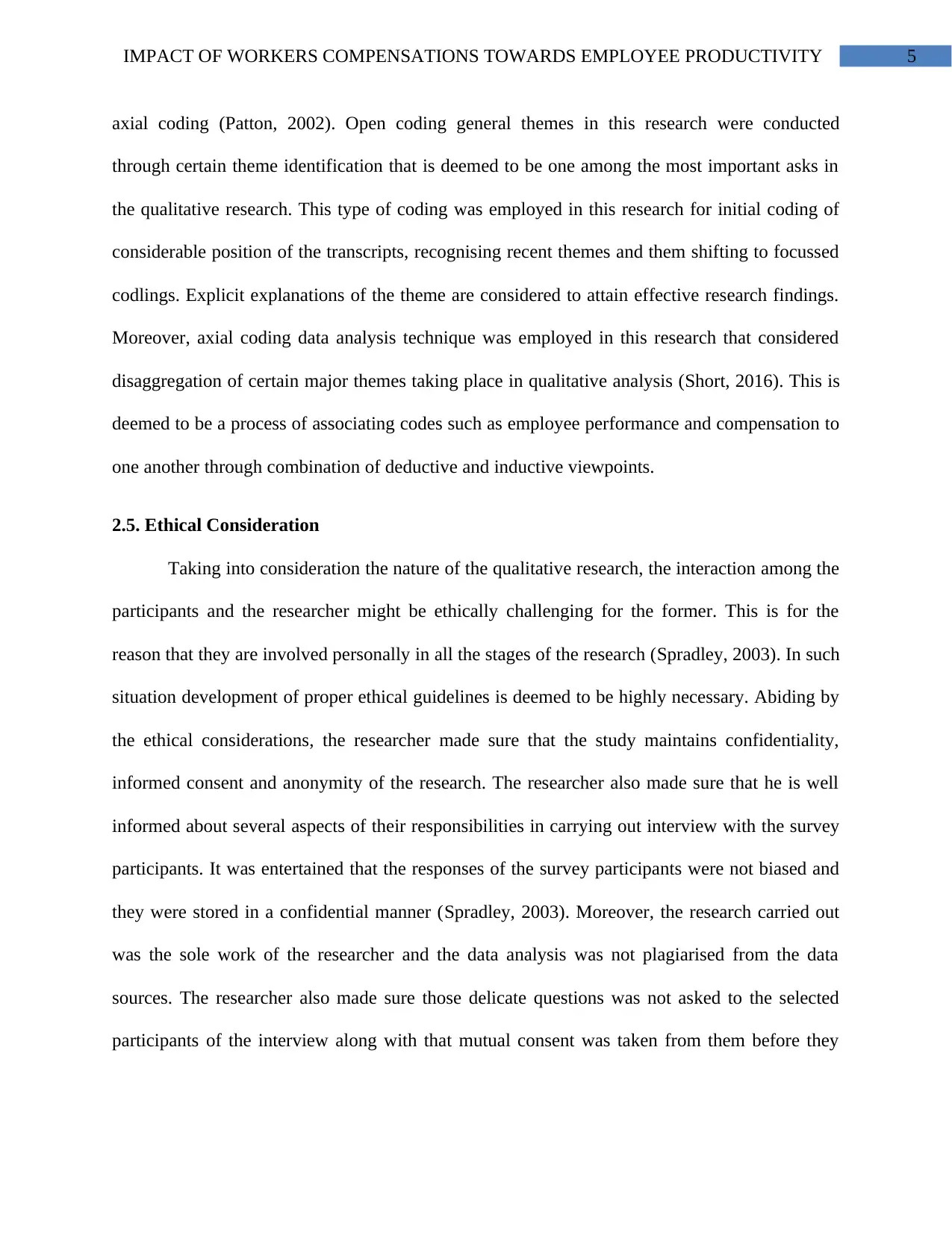
IMPACT OF WORKERS COMPENSATIONS TOWARDS EMPLOYEE PRODUCTIVITY 5
axial coding (Patton, 2002). Open coding general themes in this research were conducted
through certain theme identification that is deemed to be one among the most important asks in
the qualitative research. This type of coding was employed in this research for initial coding of
considerable position of the transcripts, recognising recent themes and them shifting to focussed
codlings. Explicit explanations of the theme are considered to attain effective research findings.
Moreover, axial coding data analysis technique was employed in this research that considered
disaggregation of certain major themes taking place in qualitative analysis (Short, 2016). This is
deemed to be a process of associating codes such as employee performance and compensation to
one another through combination of deductive and inductive viewpoints.
2.5. Ethical Consideration
Taking into consideration the nature of the qualitative research, the interaction among the
participants and the researcher might be ethically challenging for the former. This is for the
reason that they are involved personally in all the stages of the research (Spradley, 2003). In such
situation development of proper ethical guidelines is deemed to be highly necessary. Abiding by
the ethical considerations, the researcher made sure that the study maintains confidentiality,
informed consent and anonymity of the research. The researcher also made sure that he is well
informed about several aspects of their responsibilities in carrying out interview with the survey
participants. It was entertained that the responses of the survey participants were not biased and
they were stored in a confidential manner (Spradley, 2003). Moreover, the research carried out
was the sole work of the researcher and the data analysis was not plagiarised from the data
sources. The researcher also made sure those delicate questions was not asked to the selected
participants of the interview along with that mutual consent was taken from them before they
axial coding (Patton, 2002). Open coding general themes in this research were conducted
through certain theme identification that is deemed to be one among the most important asks in
the qualitative research. This type of coding was employed in this research for initial coding of
considerable position of the transcripts, recognising recent themes and them shifting to focussed
codlings. Explicit explanations of the theme are considered to attain effective research findings.
Moreover, axial coding data analysis technique was employed in this research that considered
disaggregation of certain major themes taking place in qualitative analysis (Short, 2016). This is
deemed to be a process of associating codes such as employee performance and compensation to
one another through combination of deductive and inductive viewpoints.
2.5. Ethical Consideration
Taking into consideration the nature of the qualitative research, the interaction among the
participants and the researcher might be ethically challenging for the former. This is for the
reason that they are involved personally in all the stages of the research (Spradley, 2003). In such
situation development of proper ethical guidelines is deemed to be highly necessary. Abiding by
the ethical considerations, the researcher made sure that the study maintains confidentiality,
informed consent and anonymity of the research. The researcher also made sure that he is well
informed about several aspects of their responsibilities in carrying out interview with the survey
participants. It was entertained that the responses of the survey participants were not biased and
they were stored in a confidential manner (Spradley, 2003). Moreover, the research carried out
was the sole work of the researcher and the data analysis was not plagiarised from the data
sources. The researcher also made sure those delicate questions was not asked to the selected
participants of the interview along with that mutual consent was taken from them before they
⊘ This is a preview!⊘
Do you want full access?
Subscribe today to unlock all pages.

Trusted by 1+ million students worldwide
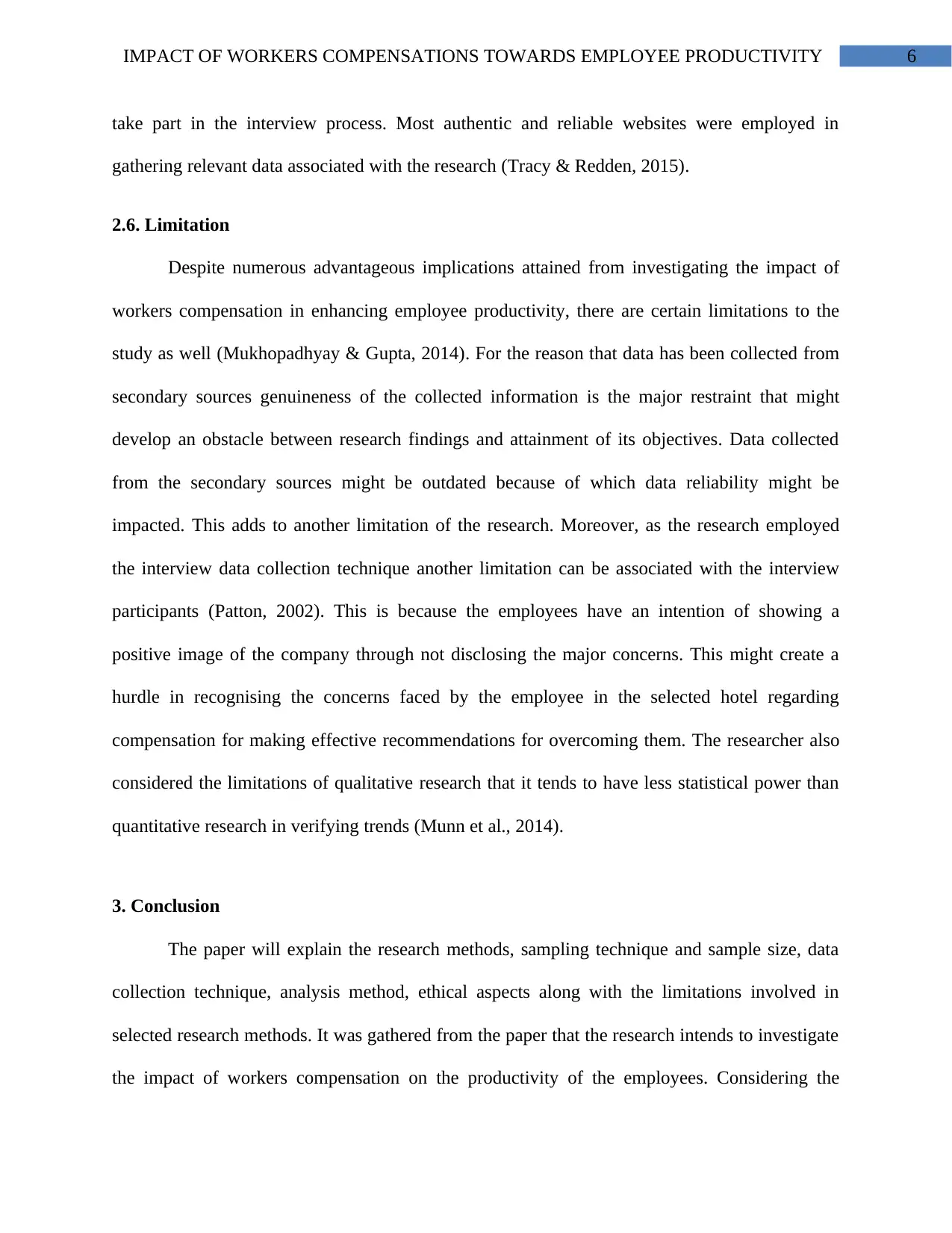
IMPACT OF WORKERS COMPENSATIONS TOWARDS EMPLOYEE PRODUCTIVITY 6
take part in the interview process. Most authentic and reliable websites were employed in
gathering relevant data associated with the research (Tracy & Redden, 2015).
2.6. Limitation
Despite numerous advantageous implications attained from investigating the impact of
workers compensation in enhancing employee productivity, there are certain limitations to the
study as well (Mukhopadhyay & Gupta, 2014). For the reason that data has been collected from
secondary sources genuineness of the collected information is the major restraint that might
develop an obstacle between research findings and attainment of its objectives. Data collected
from the secondary sources might be outdated because of which data reliability might be
impacted. This adds to another limitation of the research. Moreover, as the research employed
the interview data collection technique another limitation can be associated with the interview
participants (Patton, 2002). This is because the employees have an intention of showing a
positive image of the company through not disclosing the major concerns. This might create a
hurdle in recognising the concerns faced by the employee in the selected hotel regarding
compensation for making effective recommendations for overcoming them. The researcher also
considered the limitations of qualitative research that it tends to have less statistical power than
quantitative research in verifying trends (Munn et al., 2014).
3. Conclusion
The paper will explain the research methods, sampling technique and sample size, data
collection technique, analysis method, ethical aspects along with the limitations involved in
selected research methods. It was gathered from the paper that the research intends to investigate
the impact of workers compensation on the productivity of the employees. Considering the
take part in the interview process. Most authentic and reliable websites were employed in
gathering relevant data associated with the research (Tracy & Redden, 2015).
2.6. Limitation
Despite numerous advantageous implications attained from investigating the impact of
workers compensation in enhancing employee productivity, there are certain limitations to the
study as well (Mukhopadhyay & Gupta, 2014). For the reason that data has been collected from
secondary sources genuineness of the collected information is the major restraint that might
develop an obstacle between research findings and attainment of its objectives. Data collected
from the secondary sources might be outdated because of which data reliability might be
impacted. This adds to another limitation of the research. Moreover, as the research employed
the interview data collection technique another limitation can be associated with the interview
participants (Patton, 2002). This is because the employees have an intention of showing a
positive image of the company through not disclosing the major concerns. This might create a
hurdle in recognising the concerns faced by the employee in the selected hotel regarding
compensation for making effective recommendations for overcoming them. The researcher also
considered the limitations of qualitative research that it tends to have less statistical power than
quantitative research in verifying trends (Munn et al., 2014).
3. Conclusion
The paper will explain the research methods, sampling technique and sample size, data
collection technique, analysis method, ethical aspects along with the limitations involved in
selected research methods. It was gathered from the paper that the research intends to investigate
the impact of workers compensation on the productivity of the employees. Considering the
Paraphrase This Document
Need a fresh take? Get an instant paraphrase of this document with our AI Paraphraser
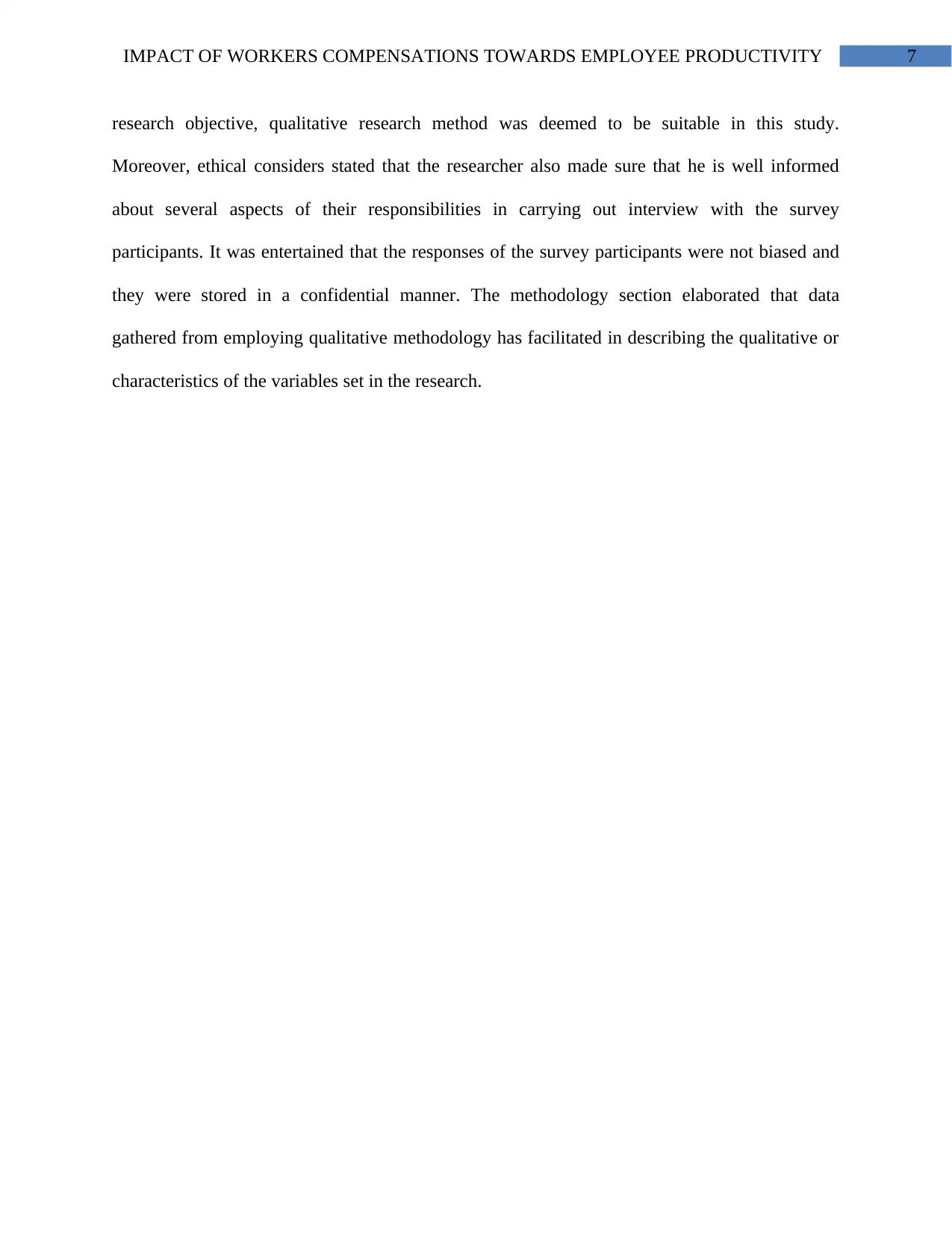
IMPACT OF WORKERS COMPENSATIONS TOWARDS EMPLOYEE PRODUCTIVITY 7
research objective, qualitative research method was deemed to be suitable in this study.
Moreover, ethical considers stated that the researcher also made sure that he is well informed
about several aspects of their responsibilities in carrying out interview with the survey
participants. It was entertained that the responses of the survey participants were not biased and
they were stored in a confidential manner. The methodology section elaborated that data
gathered from employing qualitative methodology has facilitated in describing the qualitative or
characteristics of the variables set in the research.
research objective, qualitative research method was deemed to be suitable in this study.
Moreover, ethical considers stated that the researcher also made sure that he is well informed
about several aspects of their responsibilities in carrying out interview with the survey
participants. It was entertained that the responses of the survey participants were not biased and
they were stored in a confidential manner. The methodology section elaborated that data
gathered from employing qualitative methodology has facilitated in describing the qualitative or
characteristics of the variables set in the research.
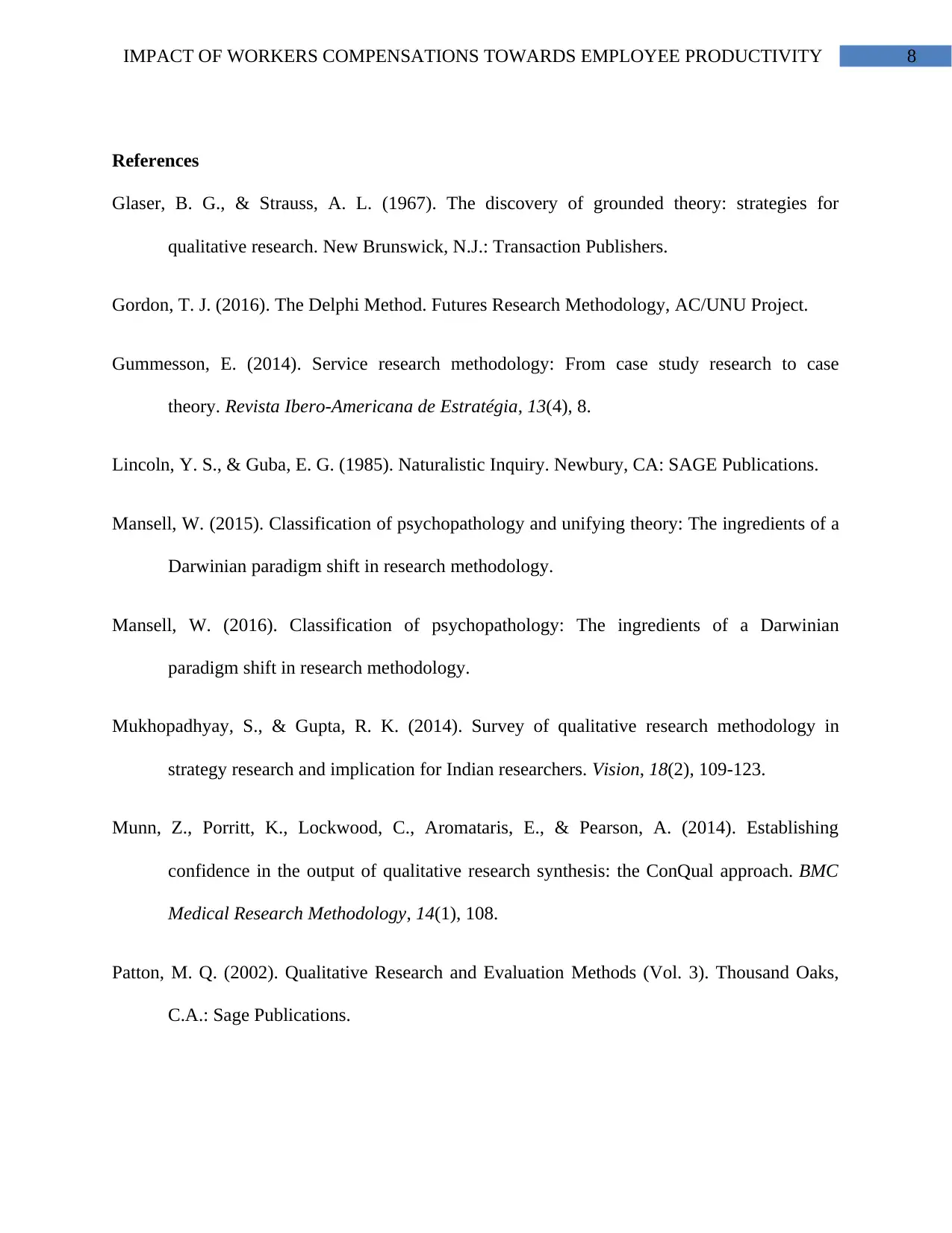
IMPACT OF WORKERS COMPENSATIONS TOWARDS EMPLOYEE PRODUCTIVITY 8
References
Glaser, B. G., & Strauss, A. L. (1967). The discovery of grounded theory: strategies for
qualitative research. New Brunswick, N.J.: Transaction Publishers.
Gordon, T. J. (2016). The Delphi Method. Futures Research Methodology, AC/UNU Project.
Gummesson, E. (2014). Service research methodology: From case study research to case
theory. Revista Ibero-Americana de Estratégia, 13(4), 8.
Lincoln, Y. S., & Guba, E. G. (1985). Naturalistic Inquiry. Newbury, CA: SAGE Publications.
Mansell, W. (2015). Classification of psychopathology and unifying theory: The ingredients of a
Darwinian paradigm shift in research methodology.
Mansell, W. (2016). Classification of psychopathology: The ingredients of a Darwinian
paradigm shift in research methodology.
Mukhopadhyay, S., & Gupta, R. K. (2014). Survey of qualitative research methodology in
strategy research and implication for Indian researchers. Vision, 18(2), 109-123.
Munn, Z., Porritt, K., Lockwood, C., Aromataris, E., & Pearson, A. (2014). Establishing
confidence in the output of qualitative research synthesis: the ConQual approach. BMC
Medical Research Methodology, 14(1), 108.
Patton, M. Q. (2002). Qualitative Research and Evaluation Methods (Vol. 3). Thousand Oaks,
C.A.: Sage Publications.
References
Glaser, B. G., & Strauss, A. L. (1967). The discovery of grounded theory: strategies for
qualitative research. New Brunswick, N.J.: Transaction Publishers.
Gordon, T. J. (2016). The Delphi Method. Futures Research Methodology, AC/UNU Project.
Gummesson, E. (2014). Service research methodology: From case study research to case
theory. Revista Ibero-Americana de Estratégia, 13(4), 8.
Lincoln, Y. S., & Guba, E. G. (1985). Naturalistic Inquiry. Newbury, CA: SAGE Publications.
Mansell, W. (2015). Classification of psychopathology and unifying theory: The ingredients of a
Darwinian paradigm shift in research methodology.
Mansell, W. (2016). Classification of psychopathology: The ingredients of a Darwinian
paradigm shift in research methodology.
Mukhopadhyay, S., & Gupta, R. K. (2014). Survey of qualitative research methodology in
strategy research and implication for Indian researchers. Vision, 18(2), 109-123.
Munn, Z., Porritt, K., Lockwood, C., Aromataris, E., & Pearson, A. (2014). Establishing
confidence in the output of qualitative research synthesis: the ConQual approach. BMC
Medical Research Methodology, 14(1), 108.
Patton, M. Q. (2002). Qualitative Research and Evaluation Methods (Vol. 3). Thousand Oaks,
C.A.: Sage Publications.
⊘ This is a preview!⊘
Do you want full access?
Subscribe today to unlock all pages.

Trusted by 1+ million students worldwide
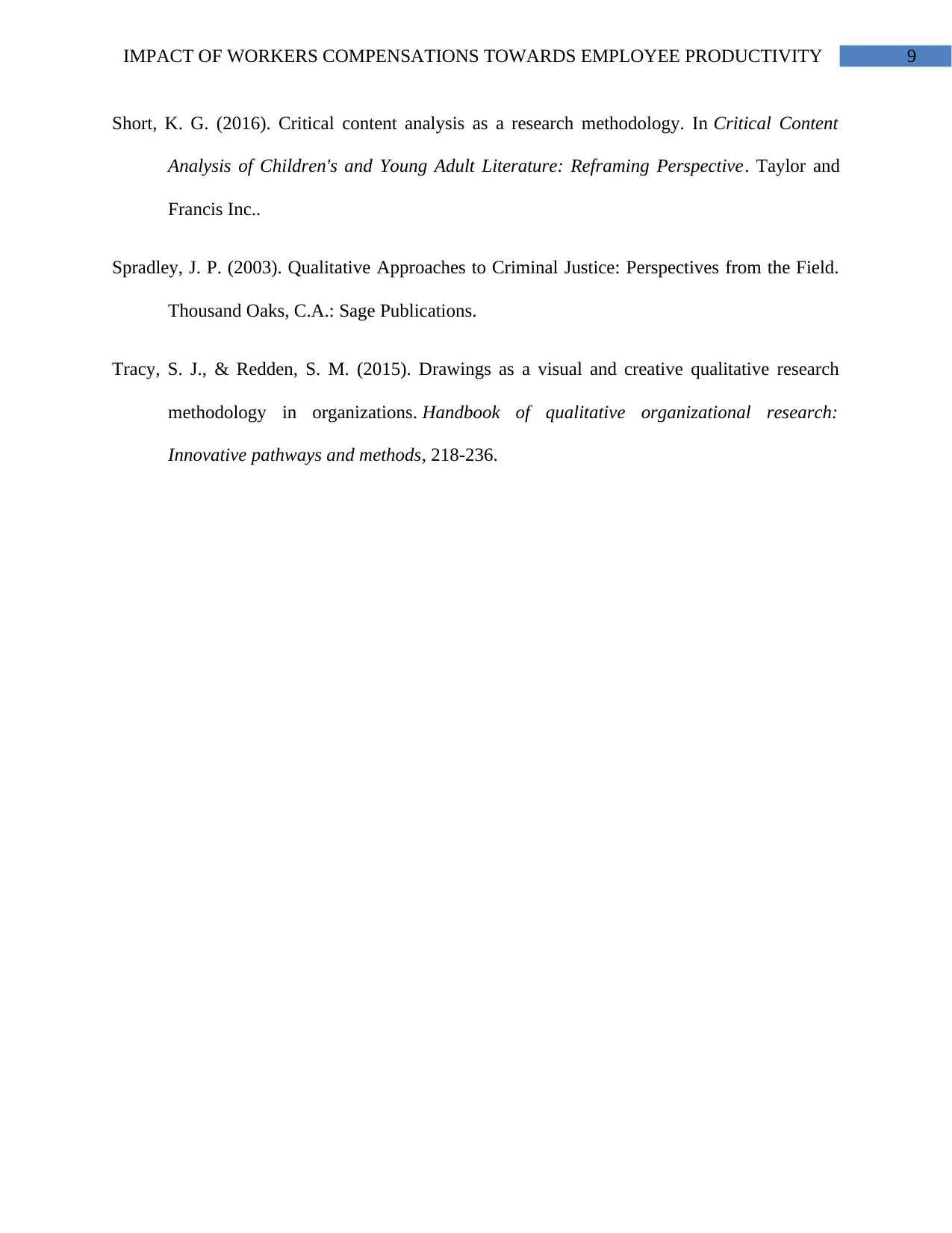
IMPACT OF WORKERS COMPENSATIONS TOWARDS EMPLOYEE PRODUCTIVITY 9
Short, K. G. (2016). Critical content analysis as a research methodology. In Critical Content
Analysis of Children's and Young Adult Literature: Reframing Perspective. Taylor and
Francis Inc..
Spradley, J. P. (2003). Qualitative Approaches to Criminal Justice: Perspectives from the Field.
Thousand Oaks, C.A.: Sage Publications.
Tracy, S. J., & Redden, S. M. (2015). Drawings as a visual and creative qualitative research
methodology in organizations. Handbook of qualitative organizational research:
Innovative pathways and methods, 218-236.
Short, K. G. (2016). Critical content analysis as a research methodology. In Critical Content
Analysis of Children's and Young Adult Literature: Reframing Perspective. Taylor and
Francis Inc..
Spradley, J. P. (2003). Qualitative Approaches to Criminal Justice: Perspectives from the Field.
Thousand Oaks, C.A.: Sage Publications.
Tracy, S. J., & Redden, S. M. (2015). Drawings as a visual and creative qualitative research
methodology in organizations. Handbook of qualitative organizational research:
Innovative pathways and methods, 218-236.
Paraphrase This Document
Need a fresh take? Get an instant paraphrase of this document with our AI Paraphraser
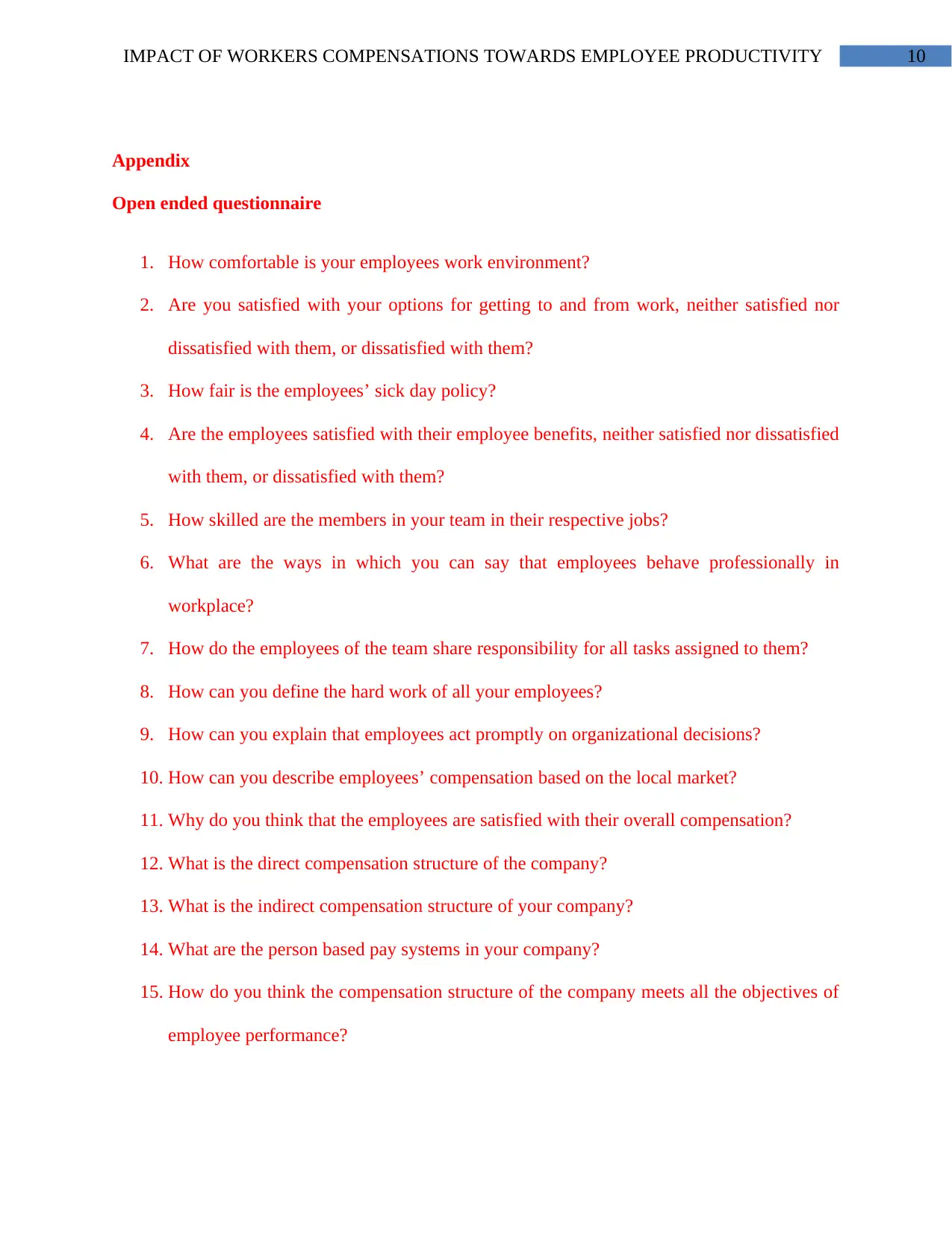
IMPACT OF WORKERS COMPENSATIONS TOWARDS EMPLOYEE PRODUCTIVITY 10
Appendix
Open ended questionnaire
1. How comfortable is your employees work environment?
2. Are you satisfied with your options for getting to and from work, neither satisfied nor
dissatisfied with them, or dissatisfied with them?
3. How fair is the employees’ sick day policy?
4. Are the employees satisfied with their employee benefits, neither satisfied nor dissatisfied
with them, or dissatisfied with them?
5. How skilled are the members in your team in their respective jobs?
6. What are the ways in which you can say that employees behave professionally in
workplace?
7. How do the employees of the team share responsibility for all tasks assigned to them?
8. How can you define the hard work of all your employees?
9. How can you explain that employees act promptly on organizational decisions?
10. How can you describe employees’ compensation based on the local market?
11. Why do you think that the employees are satisfied with their overall compensation?
12. What is the direct compensation structure of the company?
13. What is the indirect compensation structure of your company?
14. What are the person based pay systems in your company?
15. How do you think the compensation structure of the company meets all the objectives of
employee performance?
Appendix
Open ended questionnaire
1. How comfortable is your employees work environment?
2. Are you satisfied with your options for getting to and from work, neither satisfied nor
dissatisfied with them, or dissatisfied with them?
3. How fair is the employees’ sick day policy?
4. Are the employees satisfied with their employee benefits, neither satisfied nor dissatisfied
with them, or dissatisfied with them?
5. How skilled are the members in your team in their respective jobs?
6. What are the ways in which you can say that employees behave professionally in
workplace?
7. How do the employees of the team share responsibility for all tasks assigned to them?
8. How can you define the hard work of all your employees?
9. How can you explain that employees act promptly on organizational decisions?
10. How can you describe employees’ compensation based on the local market?
11. Why do you think that the employees are satisfied with their overall compensation?
12. What is the direct compensation structure of the company?
13. What is the indirect compensation structure of your company?
14. What are the person based pay systems in your company?
15. How do you think the compensation structure of the company meets all the objectives of
employee performance?
1 out of 11
Related Documents
Your All-in-One AI-Powered Toolkit for Academic Success.
+13062052269
info@desklib.com
Available 24*7 on WhatsApp / Email
![[object Object]](/_next/static/media/star-bottom.7253800d.svg)
Unlock your academic potential
Copyright © 2020–2025 A2Z Services. All Rights Reserved. Developed and managed by ZUCOL.





